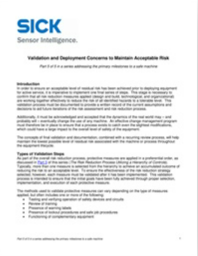Validation and Deployment Concerns to Maintain Acceptable Risk
In order to ensure an acceptable level of residual risk has been achieved prior to deploying equipment for active service, it is imperative to implement one final series of steps. This stage is necessary to confirm that all risk reduction measures applied (design and build, technological, and organizational) are working together effectively to reduce the risk of all identified hazards to a tolerable level. This validation process must be documented to provide a written record of the current assumptions and decisions to aid future iterations of the risk assessment and risk reduction process.
Download this whitepaper for more information.
Read More
By submitting this form you agree to Sick Sensor Intelligence contacting you with marketing-related emails or by telephone. You may unsubscribe at any time. Sick Sensor Intelligence web sites and communications are subject to their Privacy Notice.
By requesting this resource you agree to our terms of use. All data is protected by our Privacy Notice. If you have any further questions please email dataprotection@techpublishhub.com
Related Categories: Components, Industrial, Power, Protection Devices


More resources from Sick Sensor Intelligence

WHITE PAPER SERIES ADDRESSING THE PRIMARY MILESTONES TO A SAFE MACHINE
White Paper Number 1 addresses Selecting Safety Standards for Machine Safeguarding Requirements. White Paper 2 focusses on The Risk Assessment Proc...

Transforming the Light Curtain: Using Pattern and Object Recognition for Safer Material Transfer
Industrial safety has evolved considerably since its beginnings in the early 20th century. The number of injuries occurring on an annual basis typi...

Top 3 Applications Every Tire Manufacturer Should Safeguard
The fundamental process for making a tire hasn't changed much in 50 years. The compounds, components, and automation used in executing the process ...
